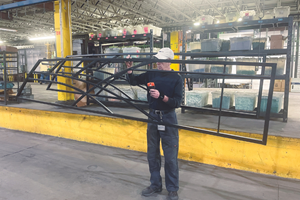Paint Recommendations
Question: We work with a number of job shops that apply powder to tubular stock that undergoes subsequent bending and punching operations.
Question:
We work with a number of job shops that apply powder to tubular stock that undergoes subsequent bending and punching operations. These shops use a lot of different powders and are constantly reviewing new ones to use. We would like to help them develop and evaluate systems that would ensure the powders they use will work well.
Can you suggest a series of questions about powders that the shop can pose to the powder supplier and tests that they can perform to make sure the supplied powder will be capable of maintaining adhesion during the forming process? Thanks for the help. M.K.
Answer:
The key to selecting the proper powder coating is to understand all the mechanical, physical, appearance and corrosion properties that the material will be subjected to and the environment in which it will be used. In your question, the issue is formability. I would venture to guess that there are other properties that may have equal importance. You have to take care to understand all the properties that you need from the selected coating, otherwise you may end up with a perfectly formable material that looks pretty bad or may prematurely corrode.
Since you asked specifically about post forming I will limit my answer to that issue. Here are some powder coating properties that are most applicable to bending and punching:
Flexibility is the capacity of a given powder to take a given bend without cracking. Measured in a given radius and degree of bend (180 degrees over a 0.125-inch mandrel), this property is verifiable by test. The reason for this property is obvious when the coated products must be bent after coating. ASTM D522 is the appropriate test method for this property.
Hardness is the capacity of a given powder to resist scratching, marring or gouging. Measured in pencil hardness (H, 2H, 3H, etc.), this property is verifiable by test. The reason this property can be important results from the tubing being placed in various tooling fixtures that can mar the coating. ASTM D3363 is the appropriate test method for this property.
Impact is the capacity of a given powder to resist a sudden blow without cracking. Measured in inch-pounds (both direct and indirect), this property is also verifiable by testing. The conditions of forming can require the tubing to be hit by forming tools to bend and punch the tubing into its final shape. Having a coating with good impact resistance will ensure that the tooling hit areas or the areas surrounding punched holes will not crack. ASTM D2794 is the appropriate test method for this property.
I caution you from just limiting your "questions" to just the mechanical formability of the powder coating. There may be some subtle issues that relate to forming powder coated tubing products. For instance, if the punching and forming operations use lubricants or oils, then the coatings may become stained. In this case stain and chemical resistance formulated into the powder coating can be equally as important as the formability of the powder coating. This fact further proves that a complete and cogent specification for the powder coating, describing all the properties that are important to meet the customer's expectations, is the only way you can obtain an appropriate powder coating material.
Related Content
Conveyors and Paint Systems
Choosing the right conveyor system, coating technology, and ancillary equipment.
Read MoreLow-Temperature-Cure Powder Coatings Offer Unique Opportunities
An in-depth look at the advantages of low-temperature-cure powder coatings and the considerations for incorporating them into your process.
Read MorePowder Coating Overcomes Post Forming
Six Sigma methodology, open communication, and collaboration produce results for leading boat manufacturer.
Read MoreCuring Oven Basics
Simply heating up the substrate does not cure the coating. There are many variables to consider when choosing the best cure oven for your application...
Read MoreRead Next
Education Bringing Cleaning to Machining
Debuting new speakers and cleaning technology content during this half-day workshop co-located with IMTS 2024.
Read MoreA ‘Clean’ Agenda Offers Unique Presentations in Chicago
The 2024 Parts Cleaning Conference, co-located with the International Manufacturing Technology Show, includes presentations by several speakers who are new to the conference and topics that have not been covered in past editions of this event.
Read MoreEpisode 45: An Interview with Chandler Mancuso, MacDermid Envio Solutions
Chandler Mancuso, technical director with MacDermid Envio discusses updating your wastewater treatment system and implementing materials recycling solutions to increase efficiencies, control costs and reduce environmental impact.
Read More





















